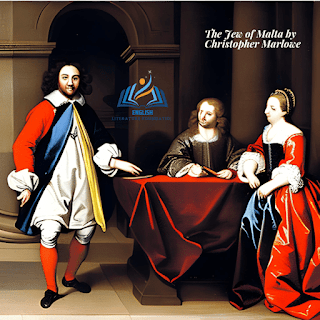The Jew of Malta: A Detailed Summary
Introduction
Overview of the play: The introduction begins
with a brief summary of the play, highlighting its plot, characters, and major
themes. This is done to give the reader a general idea of what the play is
about, and to provide a framework for the subsequent analysis and
interpretation.
Brief biography of Christopher Marlowe: The
introduction also provides a brief overview of the life and works of
Christopher Marlowe, the playwright who wrote "The Jew of Malta".
This includes information about his background, education, and literary career,
as well as some of his other notable plays.
Historical context and significance of the play:
The introduction also provides some historical context and significance for the
play, situating it within the broader cultural and political milieu of the
Renaissance period. This includes discussion of the religious conflicts and
political tensions of the time, as well as the role of theatre in shaping
public opinion and discourse.
Act I: Introduction and Rising Action
Act I serves as the exposition of the play, introducing the
main characters and setting up the conflict that will drive the plot. Here are
the main points of Act I:
- Introduction
of Barabas: Act I begins with the introduction of Barabas,
the titular Jew of Malta, who is shown counting his money and plotting
ways to increase his wealth. Barabas is portrayed as a cunning and
manipulative character who is willing to use any means necessary to
achieve his goals.
- Machiavellian
politics: Act I also introduces the political landscape of
Malta, which is shown to be characterized by Machiavellian politics and
scheming. The governor of Malta, Ferneze, is shown to be worried about the
threat posed by the Ottoman Turks, and is seeking ways to fortify the
island and raise funds for the defense effort.
- Religious
tensions: Act I also introduces the religious tensions that
will play a major role in the plot. Barabas is shown to be a devout Jew,
and is mocked by the Christian characters in the play. Meanwhile, the
Christian characters are portrayed as hypocritical and self-serving, with
many of them engaging in immoral behavior.
- Love
triangle: Act I also sets up a love triangle between
Mathias, Lodowick, and Abigail, Barabas's daughter. Both Mathias and
Lodowick are in love with Abigail, but she is initially resistant to their
advances.
- The
theft of Barabas's gold: Act I also features a subplot
involving the theft of Barabas's gold, which he has hidden in his house.
The theft is carried out by two friars, Jacomo and Barnardine, who are
shown to be corrupt and greedy.
Overall, Act I sets up the major conflicts and tensions that
will drive the plot of the play, including the political and religious tensions
in Malta, the love triangle between Mathias, Lodowick, and Abigail, and
Barabas's desire for wealth and power. The act also introduces the major characters,
including Barabas, Ferneze, Abigail, and the two friars, and establishes the
tone and style of the play, which is marked by its dark humor and cynical
worldview.
Act II: Rising Action and Plot Development
Act II continues to build on the conflicts and tensions
established in Act I, and introduces new characters and plot twists. Here are
the main points of Act II:
- The
return of Barabas's gold: Act II begins with the discovery
of Barabas's hidden gold by the friars Jacomo and Barnardine, who had
stolen it in Act I. The gold is returned to Barabas, who uses it to
further his plans for revenge and manipulation.
- The
betrayal of Mathias and Lodowick: Barabas sets his sights on
revenge against Mathias and Lodowick, who are in love with Abigail. He
tricks them into believing that Abigail has died, causing them to despair
and turn to Barabas for comfort. However, Barabas is secretly plotting
against them and eventually betrays them to the authorities.
- Abigail's
conversion to Christianity: Act II also features Abigail's
conversion to Christianity, which is portrayed as a way for her to escape
her father's influence and pursue her own desires. However, her conversion
is also shown to be motivated by a desire to win the love of Mathias, who
is Christian.
- The
plot to poison the nuns: In one of the most shocking plot
twists of the play, Barabas devises a plot to poison the nuns who have
taken in Abigail. He uses his knowledge of chemistry to create a deadly
potion, which he gives to Abigail to administer to the nuns. The plot
succeeds, and the nuns die horrible deaths.
- The
capture of Barabas: In the final scene of Act II, Barabas's
plot is discovered and he is captured by the authorities. However, he
remains defiant and unrepentant, vowing to continue his machinations even
from prison.
Overall, Act II continues to develop the political and
religious tensions in Malta, and introduces new twists and turns to the plot.
The act also features a number of shocking and gruesome scenes, including the
poisoning of the nuns, which demonstrate Marlowe's willingness to push the
boundaries of dramatic representation. At the same time, the act also
highlights the complexity and ambiguity of the play's characters, including
Barabas, who remains a compelling and fascinating figure despite his many
atrocities.
Act III: Plot Development and Complication
Act III is the climactic act of the
play, in which the various conflicts and plotlines come to a head. Here are the
main points of Act III:
- Barabas's
escape from prison: Act III begins with Barabas's escape
from prison, which he accomplishes with the help of his servant Ithamore.
This scene is notable for its depiction of Barabas's cunning and
resourcefulness, as well as its portrayal of the corrupt and ineffective
prison system of Malta.
- The
fate of Mathias and Lodowick: In Act III, Mathias and
Lodowick are put on trial for their supposed crimes, including the murder
of Abigail. However, they are ultimately acquitted thanks to the
intervention of the governor Ferneze, who sees through Barabas's
machinations.
- The
siege of Barabas's house: Meanwhile, Barabas begins to put
his ultimate plan into action: he lures all of the play's Christian characters,
including Ferneze, into his house under the guise of making a peace
agreement. Once they are inside, however, he springs a trap and reveals
that he has rigged the house with explosives. He then sets the explosives
off, killing everyone inside.
- Barabas's
downfall: Despite his apparent triumph, Barabas's schemes
eventually catch up with him. In the final scene of the play, he is
confronted by the ghost of Abigail, who reveals that she is not actually
dead but has been living in a convent. Barabas is then killed by the
poisoned dagger of Ithamore, his loyal servant who has become
disillusioned with his master's evil ways.
Overall, Act III is a fitting
conclusion to the play, bringing together the various plot threads and
character arcs in a dramatic and satisfying way. The act features some of the
play's most memorable scenes, including Barabas's escape from prison and the
destruction of his house. At the same time, the act also explores some of the
play's major themes, including the corrupting influence of wealth and power,
the dangers of religious fanaticism, and the consequences of revenge and
betrayal.
Act IV: Complication and Climax
Act IV serves as the denouement of
the play, tying up loose ends and resolving the various conflicts that have
been established throughout the previous acts. Here are the main points of Act
IV:
- Ferneze's
response to the massacre: In the wake of the destruction of
Barabas's house, Ferneze is forced to grapple with the aftermath of the
tragedy. He orders the arrest of Barabas's accomplices and works to
restore order to the city.
- The
fate of Abigail: In Act IV, Abigail emerges from the convent
where she has been living to claim her inheritance. She meets with Ferneze
and reveals that she is actually Barabas's daughter, a fact that sheds new
light on the play's events. Abigail's character arc is one of the most
compelling in the play, as she transitions from a pawn in her father's
schemes to a more independent and sympathetic figure.
- The
fate of the remaining characters: Act IV also provides
closure for the play's other characters. Mathias and Lodowick reconcile
after their shared ordeal, while the friar Jacomo is revealed to have been
secretly working against Barabas all along. Ithamore, Barabas's loyal
servant, is ultimately captured and hanged for his crimes.
- The
play's larger themes: Finally, Act IV serves as a reflection
on some of the play's larger themes, including the consequences of greed
and the corrupting influence of power. Ferneze's handling of the aftermath
of the massacre is contrasted with Barabas's amoral behavior,
demonstrating the importance of moral leadership in times of crisis.
Overall, Act IV provides a
satisfying conclusion to "The Jew of Malta," tying up loose ends and
offering insights into the play's major themes. While the play's ending is
tragic, it also offers a sense of catharsis and resolution for the audience, as
the various characters are able to find closure and move on from the events of
the play.
Act V: Falling Action and Resolution
Act V of "The Jew of
Malta" serves as the play's climax, building on the conflicts and tensions
established in the earlier acts. Here are the main points of Act V:
- The
return of Barabas: After his supposed death in Act IV,
Barabas reappears in Act V, having escaped from his tomb. He is driven by
revenge against those who wronged him and seeks to enact his revenge.
- The
fall of Ferneze: In Act V, Ferneze is revealed to be a
corrupt and ineffective leader, as he is unable to deal with Barabas's
resurgence. Barabas manipulates Ferneze into handing over his wealth and
ultimately kills him.
- The
final confrontation: The climax of Act V centers around the
final confrontation between Barabas and his enemies. Barabas enacts his revenge,
killing many of his enemies and manipulating the remaining characters to
his own advantage.
- The
resolution: The play concludes with Barabas's downfall, as
his schemes ultimately backfire and he is captured by his enemies. While
Barabas is a tragic figure, the play offers a sense of catharsis as the
other characters are able to move on from his destructive influence.
Overall, Act V of "The Jew of
Malta" is a thrilling and action-packed conclusion to the play, building
on the themes and conflicts established in earlier acts. While the ending is
tragic, it also offers a sense of closure and resolution for the audience, as
the characters are able to overcome the obstacles and challenges that have been
presented to them throughout the play.
Conclusion
The conclusion of "The Jew of Malta" by
Christopher Marlowe is a critical moment that brings together the key themes
and conflicts of the play. Here are the main points of the conclusion:
- The
fate of Barabas: The play's main antagonist, Barabas, is ultimately
brought to justice for his many crimes. He is captured by his enemies and
is left to face the consequences of his actions.
- The
resolution of conflicts: The conclusion of the play provides resolution to
many of the conflicts that were established earlier in the story.
Characters such as Ferneze and Lodowick are able to overcome their
differences and work together to bring down Barabas.
- Reflection
on themes: As the play concludes, there is a reflection on some of the
main themes of the story. The audience is reminded of the dangers of greed
and revenge, as well as the corrupting influence of power and wealth.
- Catharsis:
The conclusion of "The Jew of Malta" offers a sense of catharsis
for the audience, as they are able to see the characters overcome the obstacles
that have been presented to them. While the ending is tragic for some
characters, there is a sense of closure and resolution that provides a
satisfying conclusion to the story.
- Moral
lessons: The play's conclusion offers important moral lessons for the
audience. It encourages them to reflect on the dangers of greed and the
importance of seeking justice and fairness. The play also emphasizes the
importance of compassion and forgiveness in the face of difficult
situations.
Overall, the conclusion of "The Jew of Malta" is a
powerful and thought-provoking moment that brings together the many threads of
the story. It offers important lessons for the audience and encourages
reflection on the human condition and the dangers of corruption and greed.


